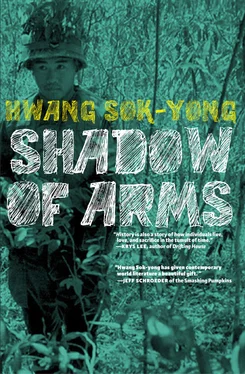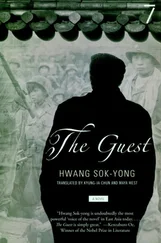Hwang Sok-Yong
The Shadow of Arms
Hwang Sok-yong’s The Shadow of Arms , when first begun in 1983, was a courageous act of political witness. Under a ferocious dictatorship, the Vietnam War remained a taboo subject except as an anti-Communist crusade. Not only had “our boys” fought and died there in great numbers, but President Chun Doo Hwan himself, along with his closest aides, was a veteran of that war. And while the larger issue of anti-imperialism and national liberation was being hotly debated in the Korean radical movements, especially among students, in the wake of the Kwangju massacre of May 1980 when General Chun came to power, such debate met with frequent and harsh repression. And here was Hwang serializing in a well-known monthly magazine a novel of the Vietnam War which exposed the atrocities and corruption of the Allied war effort, clearly sympathizing with the cause of the National Liberation Front. Little wonder, then, that once the first half was finished and came out in book form in 1985, the project remained in abeyance until after the success of the nationwide election protest actions of June 1987.
That success of the democratic movement was only partial, however, and it still took considerable daring for the author to resume work on the novel under General Chun’s successor and fellow Vietnam veteran Roh Tae Woo, bringing out the second and final volume in 1988. Freedom of expression continued to suffer severe restrictions, with any criticism of the US imperial role liable to be equated with subversiveness.
Today this particular aspect of the novel would seem to have lost much of its urgency even in South Korea, where the inauguration in early 1993 of the first civilian President in more than thirty years has brought a considerable improvement to the political and intellectual climate. To readers of the English version, especially in the United States, the almost exclusive denunciation of the latter’s role — accompanied by little criticism of the atrocities committed by South Korean troops — would appear yet more dated and even self-indulgent. While partially granting these objections, I should like to remind such readers that, first of all, Hwang’s offhand dismissal of any reason for the South Korean intervention other than the mercenary was in itself a pointed act of resistance and criticism — one, moreover, hardly matched by any subsequent South Korean work of more overt self-criticism. I may add, too, that the political issues Hwang raises have not wholly lost their relevance either: in the United States, not all the attempts to be cured of the “Vietnam syndrome” can be welcomed as moves toward true civic health.
Yet The Shadow of Arms lives today mainly as a gripping tale dealing with a fascinating aspect of the Vietnam War: the black markets of the South Vietnamese city of Da Nang. Hwang himself had some firsthand experience of them as a soldier in the South Korean Marine Corps. The main character, Corporal (later Sergeant) Ahn Yong Kyu of the Joint Investigations Headquarters in Da Nang, actually reflects a good deal of that experience and some of Hwang’s own resourcefulness and aplomb as well. True, the addition of some fictive adventures and removal of most autobiographical features tend to make the resulting characterization somewhat unreal — especially to foreign readers, since even the most expert translation cannot do justice to the racy vividness of the dialogue when the Koreans in the novel talk among themselves.
But Ahn’s character serves as the convenient — and on the whole adequate — focal point in the exciting detective work on the complicated moves by the US, NLF, South Korean, and South Vietnamese interests, with their mixtures of strategic and venal motives. And I believe a good deal of the power of this novel derives from its being more than just a realistic presentation of a little-known aspect of the Vietnam War. For the black markets, with the PXs1 of the US Military as their main fountainhead, also serve as a synecdoche of a war which, for all its irrational carnage and wastefulness, was meant to promote the interests of the hegemonic capitalist power, and hence could be terminated only when the capitalists at home finally came to object to its ultimate unprofitability.
Seen in this light, however, the various episodes and subplots supplementing the main drama of the black markets, such as the conflict in the Pham family or the reports on the atrocities by American soldiers, suffer not only from the relative thinness of the author’s firsthand knowledge but from a certain simplicity in his vision of America’s imperial role. This is not to say that the author ought to have actually depicted the more nuanced elements in the United States policy or performance. Rather, the crucial default, for a Korean novel of the 1980s, concerns the question of the nature and degree of the relevance of the anti-imperialist struggle in Vietnam to the aspirations of its Korean readers for their own reunification and genuine autonomy. The author no doubt was inspired by the similarities in the two struggles and powerfully brings some of them home. Yet given the at least equally weighty resemblances to the contrasting division of Germany, and indeed, the sui generis nature of what I have termed the “division system” on the Korean peninsula, some reflections on the differences between the national liberation struggle in Vietnam and a more complex endeavor to overcome Korea’s division would seem to have been in order. Again, this is not to demand of the author any explicit treatment of the question. Yet some appropriate details on (say) the kind of person Ahn was before he came overseas could have put his experience in Vietnam in better perspective, as well as adding to the depth and credibility of the characterization.
At all events, Hwang Sok-yong’s narrative skill manages to hold the reader’s attention to the breathtaking final shootout and beyond. There is, moreover, a profound irony in Ahn Yong Kyu’s being the man who kills Pham Minh, the NLF underground agent for whose cause and conduct the author had manifested the greatest sympathy. Perhaps the author himself does not sufficiently appreciate the irony, for in embarking for home in the last scene, Ahn does not seem to feel any particular remorse, nor does the author offer any criticism of his protagonist. But Ahn Yong Kyu’s repeated claim that South Koreans are in Vietnam simply to make what money they can, and that he himself (who is not at all venal) does only the minimum necessary for survival and honorable discharge, is given the lie by the tale. South Korea’s involvement stands condemned according to the values most passionately championed by the novel itself. While the novel’s cold-eyed detachment from the US war endeavor leaves Korean readers with the task of a more complex moral reckoning, it will also disturb American readers by reminding them of the variety and pervasiveness of their involvement in the sufferings of other nations.
Paik Nak-chung
Seoul National University
Footnote:
1 Post exchange
PREFACE FROM THE FRENCH EDITION BY EDITOR CÉCILE WAJSBROT
The Shadow of Arms is set during the Vietnam War, and describes an aspect thereof about which little is known — Korea’s participation, somewhat coerced, as an allied country alongside the American and South Vietnamese armies.
France had been out of the region for some time, following the defeat at Dien Bien Phu and in accordance with the Geneva Agreements of July 1954, which consecrated the division of the country into North and South Vietnam on either side of the Seventeenth Parallel. To the north, the Democratic Republic of Ho Chi Minh; to the south, the dictatorship of Diem and then the regime of general Thieu. The United States, which ever since the start of the Korean War in 1950 had underhandedly financed the Indochina War — the “free world’s” fight against Communism, that era’s Axis of Evil — progressively intensified its presence until undeniable engagement; August 1964, when North Vietnamese gunships attacked two American destroyers in the Gulf of Tonkin. We know the rest, the growing opposition to the war, the draft, the profound losses, the Paris Accords in 1973, and The United States’ withdrawal in 1975.
Читать дальше












